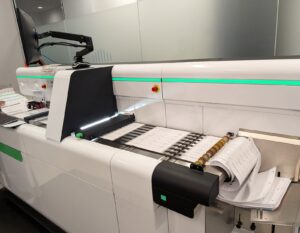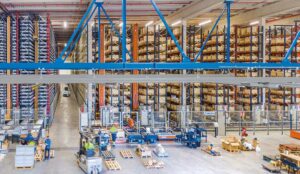The rapid growth of e-commerce has revolutionized how businesses operate, bringing many new challenges and opportunities. As consumers increasingly demand faster delivery times, greater accuracy in order fulfillment, and a wider selection of products, businesses must adapt their operations to meet these expectations. One of the key technologies that can help e-commerce businesses stay competitive is the Vertical Lift Module (VLM). VLMs are automated storage and retrieval systems that optimize space, improve efficiency, and enhance accuracy in order fulfillment. This blog will explore VLMs’ specific challenges and opportunities in e-commerce operations and how they can be leveraged to improve overall business performance.
The E-commerce Fulfillment Landscape
E-commerce fulfillment involves receiving, processing, and delivering online orders to customers. This complex process involves multiple steps: inventory management, picking and packing, shipping, and returns management. As online orders increase, so does the need for efficient and accurate fulfillment processes. This is where VLMs can play a crucial role.
VLMs are automated storage systems that use a vertical lift mechanism to store and retrieve items from a series of trays within a compact storage density unit. By utilizing the full height of a facility, VLMs can significantly increase storage capacity while reducing the amount of floor space required. This is particularly important in e-commerce operations, where space is often premium and efficient storage solutions are critical.
Challenges in E-commerce Fulfillment
E-commerce warehouses face many challenges in staying ahead of the competition. They need to make the most of their floor space, keep order picking accurate, and deal with changing labor costs. Fast order fulfillment is another big goal. Let’s look closer at each challenge and how it affects e-commerce operations.
Space Constraints
One of the primary challenges in e-commerce fulfillment is the efficient use of available space. As businesses grow and online orders increase, additional storage capacity becomes apparent. Traditional storage methods, such as shelving and pallet racking, can quickly become inadequate, leading to overcrowded warehouses and inefficient workflows. This can result in longer picking times, increased labor costs, and a higher likelihood of errors.
Order Accuracy
In the e-commerce industry, order accuracy is paramount. Customers expect their orders to be fulfilled correctly and delivered on time. Errors in order fulfillment can lead to dissatisfied customers, increased returns, and additional costs associated with re-picking and re-shipping items. Maintaining high levels of accuracy in a fast-paced, high-volume environment can be challenging, particularly when relying on manual picking processes.
Labor Costs
Labor costs represent a significant portion of operational expenses in e-commerce fulfillment. As order volumes increase, so does the need for additional labor to handle the picking, packing, and shipping processes. However, labor shortages, rising wages, and the need for skilled workers can make it difficult for businesses to keep up with demand while controlling costs.
Speed and Efficiency
In the competitive world of e-commerce, speed is a critical factor. Customers expect their orders to be processed and shipped quickly, with many expecting same-day or next-day delivery options. This requires fulfillment centers to operate at peak efficiency, with streamlined processes and minimal downtime. Traditional storage and manual picking processes can create bottlenecks and slow fulfillment, leading to delays and missed delivery window
Inventory Management
Effective inventory management ensures the right products are available to fulfill customer orders. In e-commerce, this can be particularly challenging due to the wide variety of products offered and the constant fluctuations in demand. Overstocking can lead to wasted space and increased carrying costs while understocking can result in stockouts and missed sales opportunities.
Returns Management
Returns are an inevitable part of e-commerce, and managing them efficiently is crucial for maintaining customer satisfaction and controlling costs. Processing returns quickly and accurately requires a well-organized storage system to handle the influx of returned items and integrate them into inventory.
Opportunities for VLMs in E-commerce Fulfillment
Maximizing Space Utilization
VLMs are designed to maximize vertical space, often underutilized in traditional warehouses. By using the full height of a facility, VLMs can increase storage capacity by up to 90% compared to conventional shelving systems. This allows e-commerce businesses to store more products in the same space, reducing the need for costly warehouse expansions or relocations. Additionally, the compact footprint of VLMs frees up valuable floor space, which can be used for other essential operations, such as packing and shipping.
Enhancing Order Accuracy
One key advantage of VLMs is their ability to improve order accuracy. VLMs use advanced software to manage inventory and guide operators to the correct items for picking. Features such as laser pointers, put-to-light systems, and alphanumeric LED bars help ensure that the right items are picked every time, reducing the risk of errors. This increased accuracy leads to fewer returns, lower re-picking costs, and higher customer satisfaction.
Reducing Labor Costs
VLMs automate many aspects of the picking process, reducing the need for manual labor. By bringing items directly to the operator, VLMs eliminate the need for workers to walk long distances or search for products, significantly reducing picking times. This increases efficiency and reduces labor costs by allowing fewer workers to handle higher unit load of orders. Additionally, the ergonomic design of VLMs minimizes physical strain on workers, leading to lower injury rates and reduced absenteeism.
Improving Speed and Efficiency
VLMs are designed to streamline the picking process, making it faster and more efficient. Items are stored in trays automatically brought to the operator, reducing the time it takes to locate and retrieve products. Advanced software to manage inventory and optimize picking sequences further enhances speed and efficiency. This allows e-commerce businesses to process and ship orders faster, meeting customer expectations for fast delivery.
Optimizing Inventory Management
VLMs provide real-time visibility into inventory levels, making it easier for e-commerce businesses to manage their stock. Integrating VLMs with warehouse management systems (WMS) allows for accurate inventory tracking, reducing the risk of stockouts or overstocking. The ability to store various items, from small components to larger products, makes VLMs a versatile solution for managing diverse inventories. This optimized inventory management ensures that the right products are always available to fulfill customer orders, improving overall business performance.
Efficient Returns Management
VLMs can also play a crucial role in managing returns. By providing a well-organized storage system, VLMs make it easier to process returned items and reintegrate them into inventory. The ability to quickly locate and retrieve products also speeds up the return process, reducing the time it takes to get items back into stock and available for sale. This efficient returns management helps e-commerce businesses maintain customer satisfaction and control costs.
Case Studies: VLMs in Action
Let’s look at real-life examples of VLMs changing e-commerce fulfillment operations. These case studies show the real benefits that businesses get by adding VLMs to their warehouse plans.
Symrise
Symrise, a flavor and fragrance provider in Manhattan, faced space constraints in its laboratory environment. By installing Modula Sintes1 lifts, it could store small bottles and reference samples efficiently on the upper floor of a high-rise building. The VLMs were installed with a clearance height of less than 10 feet, making the most of the available space while ensuring easy access to stored items. This optimized storage solution allowed Symrise to improve its inventory management and streamline laboratory operations.
Conclusion
As the e-commerce industry evolves, businesses must adapt to the growing demands for faster, more accurate order fulfillment. Vertical Lift Modules (VLMs) offer a powerful solution to the challenges of inventory control, providing opportunities to maximize warehouse space, enhance order accuracy, reduce labor costs, and improve overall efficiency. By leveraging the benefits of VLMs, e-commerce businesses can stay competitive, meet customer expectations, and achieve long-term success.
Whether you are looking to optimize your existing warehouse operations or plan for future growth, VLMs provide the flexibility, scalability, and efficiency needed to thrive in the fast-paced world of e-commerce. Contact us today to learn how Modula Vertical Lift Modules can transform your e-commerce fulfillment operations and help you achieve your business goals.
What is a vertical lift module (VLM) and how does it work?
A vertical lift module (VLM) is an automated storage and retrieval system that consists of two columns of trays with a lift in the center. The lift retrieves trays with stored items based on computerized commands, optimizing space utilization and order picking efficiency in e-commerce fulfillment centers.






